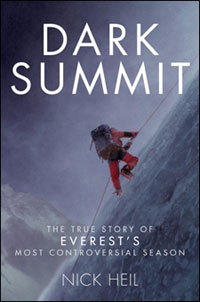|
| ||
| A trip to the ‘Dark Summit’ SideStory: Maria’s to host kick-off event
by Joe Foster Dark Summit: The True Story of Everest’s Most Controversial Season by Nick Heil. Henry Holt and Company, 2008. 288 pages. Life above 8,000 meters maintains a tenuous, earthly hold in the best of conditions. The human body is simply not built to survive in subzero temperatures and an atmosphere so thin it turns the blood to a thick, bisque-like sludge. Despite this, hundreds of people each year, most of them amateurs who have no business in such a place, attempt to summit the world’s highest and most inhospitable peak. Mount Everest claims the lives of some of the most experienced mountaineers in the world every year, yet flatlanders who have never before been above 24,000 feet, much less to Everest’s 29,000 plus, still fork out thousands to give it a go. There are companies in place that make such a feat as possible as possible, but the people in charge of such expeditions will pull the plug on a struggling climber’s summit bid without hesitation. When a climber reaches the summit, they’re really only half way there, and most deaths occur on the descent; climbers at this point have spent enormous amounts of energy to reach the top of the world, and it’s difficult to gauge what’s left for the trip home. This is what the expedition leaders are for, and they remain in constant contact with their climbers. Despite all the safety nets in place, people die. Like any worthy endeavor, Everest has become a money-making operation on a grand scale for a few people savvy enough to realize its potential relatively early. Like the professional river runners of the Grand Canyon, Everest guiding companies range from spartan to posh in their accommodations, charging tens of thousands of dollars to give their clients the best adventure possible, with the most likely odds of survival for the untried. Outside magazine’s Nick Heil goes into incredible detail about this dynamic in his new book, Dark Summit: The True Story of Everest’s Most Controversial Season. The controversial season he refers to here is 2006, the deadliest since the infamous 1996 season. This season showed the darker side of Everest in vivid contrast to the romance so often associated with high-stakes mountaineering. Picture this: a young and relatively experienced Brit climber named David Sharp lies on the side of the path, exhausted, sans oxygen, quickly freezing to death. Now picture a train of 40 fellow climbers trudging past him, effectively ignoring him, and, so, effectively allowing him to die. Technology is ubiquitous even here, at one the most remote places on Earth, and word of this man’s death and the circumstances surrounding it hit the Internet almost immediately. The world was shocked at the apparently soulless and selfish drive these climbers displayed. Critics focused most of their ire on one man, Russell Brice. The Boss Hog of Everest mountaineering, Brice runs the largest and most Heil does a fabulous job of viewing this controversy from all angles, essentially reserving judgment, mostly and allowing the realities of such endeavors to speak for those involved. He raises the most basic question: was it possible to save David Sharp? He also asks a few that are a bit less basic. If not possible, should the 40 climbers, barely clinging to life themselves so high above hospitable parts of the world, have tried anyway? Do other climbers have the responsibility to save someone in over their heads, knowing full well that such depths can be reached by the smallest of miscalculations? Do the most cherished rules of humanity exist above 8,000 meters? Well, I don’t know if these questions have answers, but in Dark Summit, Heil explores them as fully as possible in a truly riveting account of one hell of a season on the mountain. •
|


